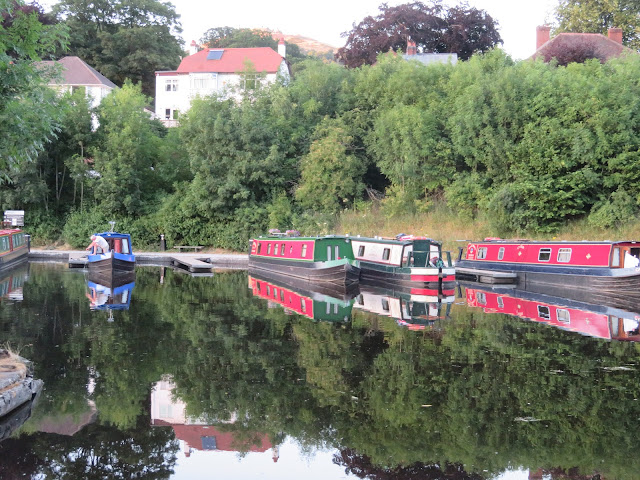After mooring up and having a bite to eat we set off to join the crowds in Llangollen. It is always a little disconcerting being in crowds, for a short time, after being on the canals, and being a nice weekend there were plenty of folk about.
We saw our shop was open and seemingly doing okay. Good for the retirement any way!
After a wander about getting our bearings we retired to the garden of the Hand Hotel with a drink in the shade and a view of the River Dee. Opposite was the landing spot for the white water rafting trips. All for a mere £55 it seems.
Back to the boat for a nice quiet evening in the basin. However they were doing a few sound checks for the Eisteddfod which is in the field opposite. Oh and I did wash the port side of the boat.
Next morning we had decided to take a trip on the Llangollen Railway. The line used to run to Ruabon and Barmouth, what a great trip that would be. It closed in 1965 just a century after it had opened.
Just before the first station, Berwyn, the railway cross the Dee with great views up the valley.
Berwyn Station is right next to the Chain Bridge and hotel. The first chain bridge was erected in 1818. It was used to carry cargoes from the canal, just behind the hotel, to the newly built Shrewsbury - Holyhead trunk road built by Telford, now the A5. It was one of the first chain bridges in the world. The second bridge was built in 1876 using the original chains by Henry Robertson a railway engineer and industrialist. His son, Sir Henry Robertson, again rebuilt the bridge as a foot bridge only, after it had been damaged by flooding. It reopened in 1929, but was closed in 1984 on safety grounds. It reopened in 2015 using the original, and oldest suspension chains still in use, as the overhead chains.
Because of the prolonged dry weather, and in common with other heritage railways, they are only using diesels to reduce the fire risk. These old Deltics still make a throaty roar that is very different to the current engines.
We got off at the terminus at Corwen. The heritage railway reached here in 2014. The temporary station is just outside the town, but the plans to have a proper station in the middle of the town is well advanced and is taking shape to be opened late this year, or next. We visited the little local museum that is free to enter and we spent about 90 minutes getting the local information and frequently changing displays. Just across the road is Corwen Manor. It was originally built as a Union workhouse for seven parishes in 1840. It could accommodate 150 paupers, men and women in opposite wings. Following Telford's remodeling of the trunk road to Holyhead Corwen was a very busy place.
In the Market Place is the statue of Owain Glydowr. His family's estates were close by and in 1400 he declared himself the Prince of Wales. Over many years there were running battles with the Marcher Lords and Henry V. By 1415 the game was up. Owain Glydowr dissappeared and the legend lives on as the 'Father of modren Wales'.
Opposite is the coaching in of the same name, the Owain Glyndwr Hotel. It came into its own following the opening of the Telford road in the early 19th Century. Before that it had been a monastery in the grounds of St. Mael and St. Sulien that was founded by those saints in the 6th Century. The current building dates from 1200's. The car was one of a pair out for a run in the sunshine.
As there is only a single track at Corwen the engine can not go to the front of the train. Because of this the restriction of view means that only 5 coaches are allowed to Corwen, and a reduced speed to the next station Carrog, where there is a double track and a run round for the engine is possible.
It is very popular to complain about train transport these days, but when you travel on these heritage lines the old coaches are not the height of comfort and the ride along the tracks is also not as comfortable. How easily we forget the past. I think there are double the number of passengers using the trains today and many more journeys made than when it was first privatised.
We decided to go for a walk to the Horseshoe Falls at about 2100
. It turned out to be a little further than we had thought but we didn't pass many people. As we walked past the basin 'Holderness' was sitting safely.
It turns out that the Horseshoe Falls are in fact 'J' shaped. You have to admire the skills of the canal planners as getting the water levels right, right round the system must be a difficult job these days, never mind then when it was all done by theodolite and chains. Calculating how big to make the weir as well as how high couldn't have been easy without a calculator etc. It was well worth the walk and really nice to have the place to ourselves.














No comments:
Post a Comment